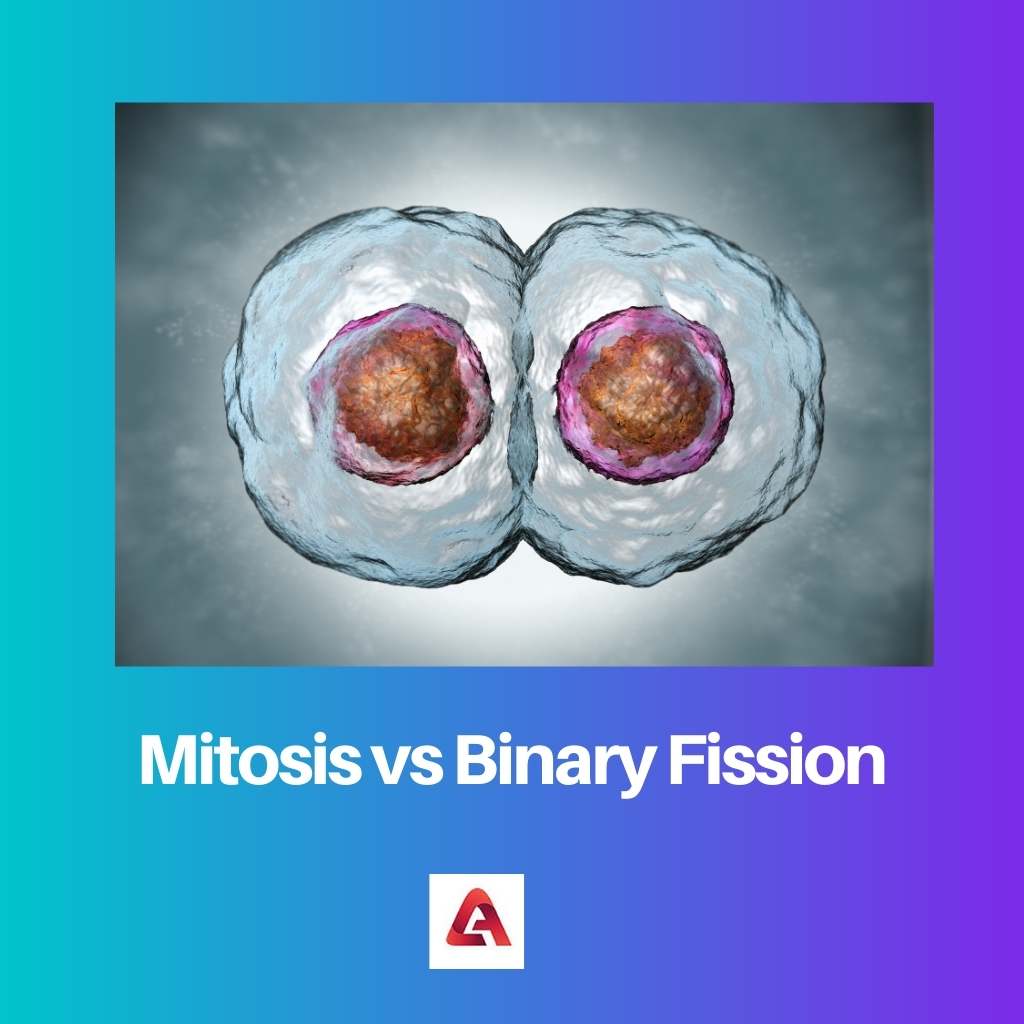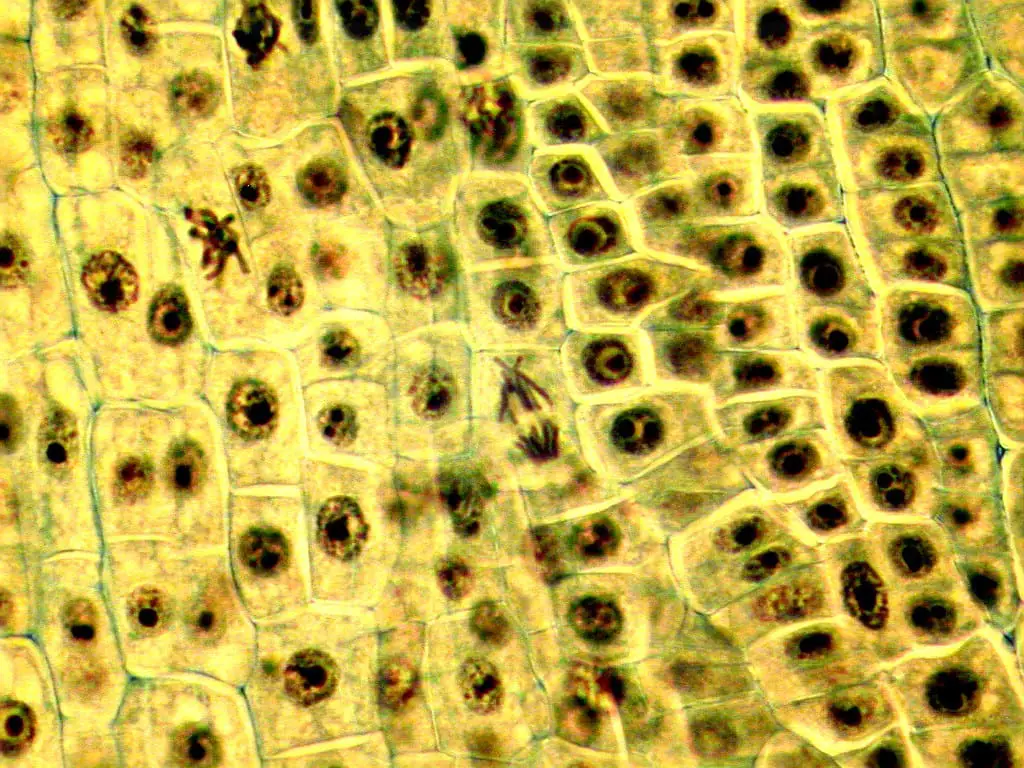Mitosis and Binary Fission are both terms used in the biology branch of science. The concept of the terms is the same, being that both are forms of asexual reproduction, in which a parent cell divides itself to form two identical cells.
Though the concept is the same, many key differences exist, including the process.
Key Takeaways
- Mitosis occurs in eukaryotic cells, whereas binary fission occurs in prokaryotic cells.
- Binary fission results in two identical daughter cells, while mitosis produces two genetically diverse daughter cells.
- Mitosis involves multiple stages, including prophase, metaphase, anaphase, and telophase, whereas binary fission consists of a simple division process.
Mitosis vs Binary Fission
Mitosis is a process carried out by a cell when it replicates its chromosomes and segregates them, producing two equal nuclei that are the replicas of the parent cells. Binary fission is a form of asexual reproduction where the parent cell divides into two identical cells, and this is observed in prokaryotes.

Mitosis is a cell division process in which the cell divides itself into two daughter cells with the same chromosomes as the parent nucleus. The chromosomes are replicated.
It increases the number of cells in plants and animals. It occurs in somatic cells.
The process of mitosis is important for the growth, repair, and development of cells.
Binary Fission is a type of asexual reproduction in prokaryotes. Unicellular organisms like amoeba reproduce by binary fission.
It’s a faster process of cell division. The cell divides into identical halves, each growing the same size as the parent organism.
Comparison Table
| Parameters of Comparison | Mitosis | Binary Fission |
|---|---|---|
| Occurs in | The process of mitosis occurs in eukaryotes. | The process of binary fission occurs in prokaryotes. |
| Speed | Mitosis is a slow process. | Binary fission is a rapid process. |
| Types | There are no types of mitosis. | There are 4 types of binary fission. |
| Phases | There are 5 phases in the process of mitosis. | There are no phases. |
| Spindle Formation | Mitosis includes spindle formation. | Binary fission does not include spindle formation. |
| Sister Chromatids | Mitosis included the sister chromatids. | The binary process does not include the sister chromatids. |
| DNA | The DNA is attached to the mitotic spindle. | The DNA is attached to the cell membrane. |
| Chromosome’s Increment | Chromosomes did not increase. | Sometimes the chromosomes increase in number. |
What is Mitosis?
Mitosis occurs in organisms whose cells have a nucleus, i.e. eukaryotes. It is a complex and slow process.
The cells divide themselves into two parts. The parts are the replicas of the parent cells.
The process increases the number of cells during the blastogenesis and embryogenesis of animals and plants.
The process is divided into 5 phases: prophase, prometaphase, metaphase, anaphase, and telophase. Through these five phases, in the prophase, the linear chromosomes replicate.
In the prometaphase, the nucleus membrane disintegrates, and fibre organizes to form the mitotic spindle. In the metaphase, chromosomes align on the spindle with the help of microtubules, and the DNA attaches to the spindle for division.
In anaphase, the two sets of chromosomes are lured away from each other through the spindle. In the last phase, telophase, the spindles and chromosomes move to opposite sides of the cell, a nuclear membrane is formed around each content, and the cell membrane separates into two cells.
Mitosis is a slow process, so it takes more time to occur, mostly a total of 70 to 180 minutes. The main function of the process is the growth, repair, and development of the cells.
And also to replace the cells which are worn out.

What is Binary Fission?
Binary Fission occurs in organisms whose cells do not contain a nucleus, i.e. prokaryotes. For example, unicellular organisms like amoeba.
Binary Fission is also known as prokaryotic fission. It is a form of asexual reproduction in which the cells divide and split themselves into equal parts.
The organism duplicates its DNA into two parts, each part receiving the same DNA. The DNA in this process is attached to the cell membrane.
The two new cells have the ability to grow the same size as the parent cell.
It is a fast process to reproduce, and many prokaryotes organisms take only minutes to complete the process. Like E. Coli, a bacteria that divides and completes the binary fission process in 20 minutes.
Indeed, it is a simpler process and so it doesn’t have any phases.
Though there are 4 types of binary fission:
- Irregular in which the cells divide at any plane,
- Longitudinal in which the cell divides longitudinally,
- Transverse in which the cell divides along the transverse axis
- And the Oblique binary fission in which the cell divides obliquely can be left or right oblique.
The binary process doesn’t involve any phase, meaning it doesn’t need to form a spindle. Neither does it involve the sister chromatids.

Main Differences Between Mitosis And Binary Fission
- Mitosis occurs in eukaryotes, while binary fission occurs in prokaryotes.
- Mitosis is a slower process than binary fission.
- Mitosis is a complex process, while binary fission is a simple process.
- There are no types of mitosis processes. There are many types of binary fission.
- Mitosis takes place in plants and animals, while binary fission takes place in bacteria and unicellular organisms like an amoeba.
- The process of mitosis happens in 5 phases, while there is no phase in the process of binary fission.
- The mitosis process involves the sister chromatids, while the binary fission does not.


The detailed explanation of the phases involved in mitosis and binary fission enhances the understanding of these processes. Excellent work in breaking down complex concepts.
The distinction between mitosis and binary fission is made evident through the speed, type, and structural differences. This article serves as a valuable resource for academic study.
The references provided at the end of the article add credibility to the information presented. It’s important to support scientific knowledge with reputable sources. Well done.
The description of mitosis and binary fission highlights the significance of these cellular processes in the growth and reproduction of organisms. The clarity and depth of information are commendable.
I echo your sentiments, Courtney70. The intricate details provided in the article enhance our understanding of these fundamental biological processes.
The comparison table provides a clear overview of the key differences between mitosis and binary fission. This is a useful reference for students and researchers in biology.
The comparison between mitosis and binary fission elucidates the fundamental dissimilarities in the division mechanisms of eukaryotic and prokaryotic cells. A well-structured and informative piece.
The article effectively outlines the primary differences between mitosis and binary fission, providing an in-depth analysis that contributes to the understanding of cellular biology.
The intricate details presented in the article facilitate a profound understanding of the complex processes of mitosis and binary fission. A commendable contribution to the scientific discourse.
The detailed examination of each process reveals the intricate mechanisms of mitosis and binary fission. An intellectually enriching piece of work.
The article provides a comprehensive analysis of the differences between mitosis and binary fission. It’s quite informative and well-structured.